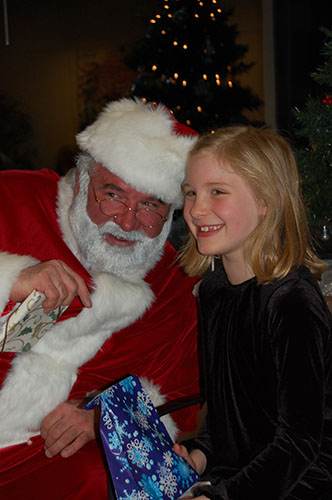Mythological characters inspire magical moments

Smiling with Santa Claus (left), the Easter Bunny (center) and her younger sister (right), Gwyn Skiles celebrates Christmas and Easter as a young child. Much of Skiles’s fun and festivity during the holidays came from her belief in these mythological characters, which she maintained through the age of eight.
December 14, 2018
I work at a café with a single mother named Maria* and I often ask her about her three-year-old son, Chester*. This upcoming holiday season, Maria was telling me how Chester is starting to comprehend the Santa tales his teachers read to him, and often will extend his chubby hands to grab toys off the shelves at Target, asking whether or not they will appear on his mantle. Yet Maria emphasized that without a partner to help her make decisions, she is struggling with whether or not to “lie to her kid” and pretend she’s Santa Claus.
As a teenager, I hadn’t thought about the implications of mythological characters such as Santa, the tooth fairy, and the Easter Bunny that I believed in as a child. It never clicked in my mind that my parents were deceiving me into believing in Santa, an all-powerful being that would give me presents if I behaved or coal if I didn’t. Yet, I believe that the true purpose of these mythological characters is not to deceive children into behaving better, though this is a common misunderstanding.
The Santa threat didn’t work, and there didn’t need to be a threat in the first place. I was very obnoxious and loud as a kid. It would drive my family crazy, and I often heard “GWYN! CALM DOWN!” or “GWYN! YOU’RE TOO LOUD!” Did I constantly worry about Santa watching me and judging my behavior? No. I mostly feared my parents putting me in time-outs. And still, I never got coal.
So if the threat doesn’t work, why lie?
Because it’s fun for everyone.
On Christmas Eve, I was always curious about the presents I would get, and I would constantly wonder if Santa was downstairs in my living room. I finally would fall asleep around 12 a.m., only to wake up at 4 a.m to sneak downstairs and look at the nicely wrapped presents under my Christmas tree.
These magical memories, along with the excitement of placing my tooth under my pillow and searching for plastic eggs in my yard, are the fondest I have of my childhood. I sat down with my mom, and she emphasized how she thought the magic of the season was more important than the schemes behind it.
“It was a fun tradition I was carrying on from my childhood, and I wanted to create the magic, wonder, and excitement of the holiday for you and your sister,” my mom explained.
I learned that Santa, the tooth fairy and the Easter bunny weren’t real when I was about eight years old. My Dad brought me into his office while I was crying and wailing, wanting him to tell me the truth. However, after discovering that they weren’t real, rather than being sad, I felt really cool, knowing the great secret before my sister and cousin. Even more so, the truth provoked me to be even more curious.
When the fantasy of Santa ended, I continued to live my life as if there were a more “mature” Santa Claus. It was then that I felt I started to make the transition from childhood to adulthood. The mystery I sought answers to was no longer if the almighty power of Santa was real, but rather if there is another almighty power. The alternate realities I began to run towards to fill my imagination with fantasies were theatre, music and literature.
So in some ways, Santa, the tooth fairy and the Easter Bunny aren’t lies more than they are inspiration. Inspiration for excitement, inspiration for how to live as an adult and inspiration for the magical moments in society.
*Names have been changed


